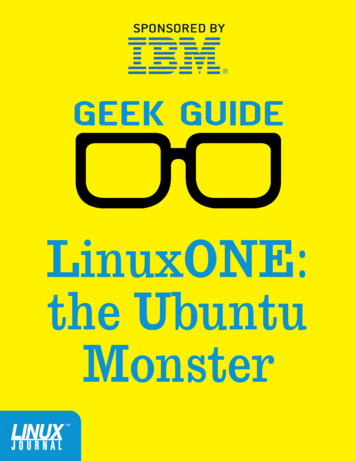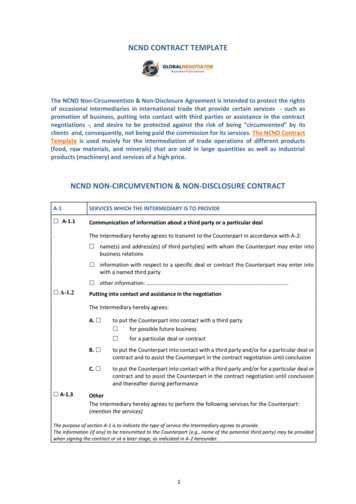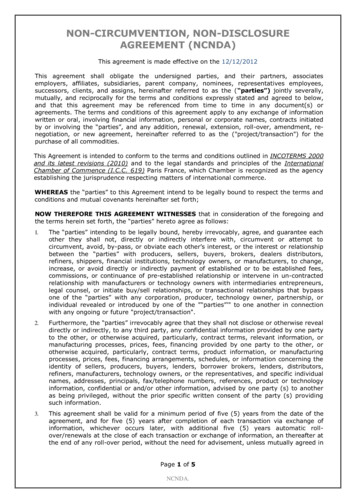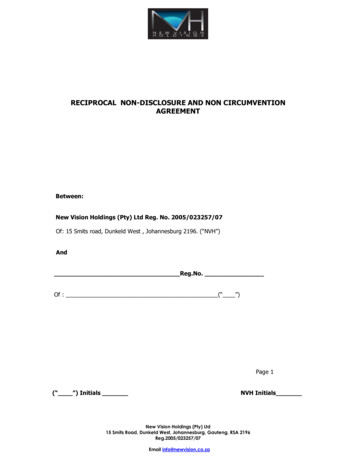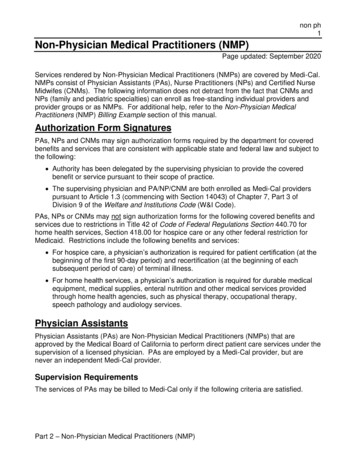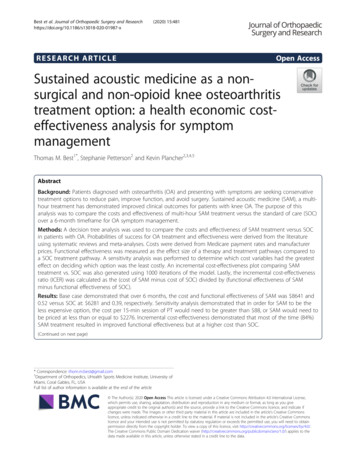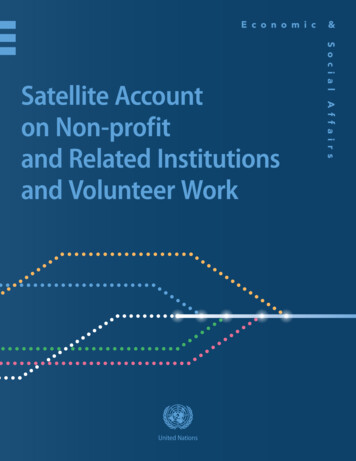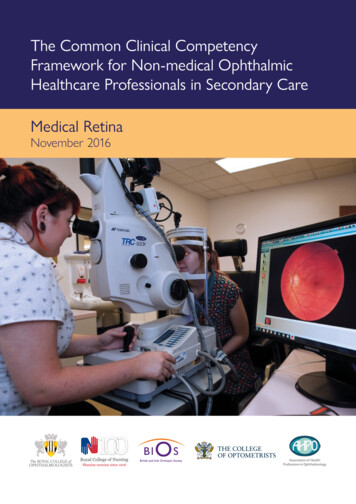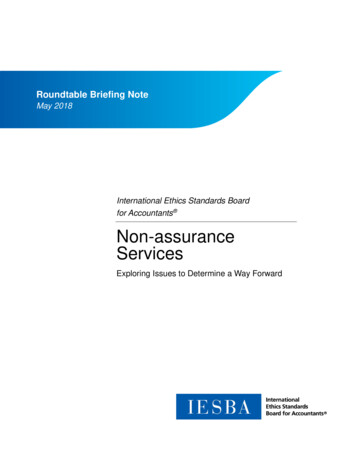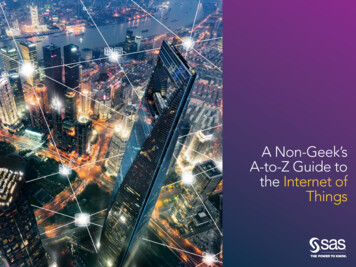
Transcription
A Non-Geek’sA-to-Z Guide tothe Internet ofThings
IntroductionTh e N o n - G e e k ’s G u i d e t o t h e I n t e r n e t o f Th i n g sIntroductionDifferent Ways to View IoTDefining the Internet of Things isn’t easy. When it’s defined in terms of marketsize, some focus on the potential revenue (it’s in the trillions), while othersfocus on the number of potential “things” (it’s in the billions). Some definitionsfocus on the exponential growth of sensors, excluding smartphones, tabletsand desktop computers, while others only consider devices with an IPaddress. Whether these definitions and forecasts are accurate or not, it can bedownright confusing.While you won’t find a canonical definition of IoT in this guide, it’s stillinteresting to note how different organizations describe it. Here are a few:How would you define the Internet of Things (or IoT, as it is commonly called)?If you were to ask 20 people, you would most likely end up with 21 differentdefinitions, including yours. And guess what? That’s OK. It’s not important thatwe all agree on a single definition. What’s important is that we understandthe context or frame of reference in which the Internet of Things is beingdiscussed.A good case in point is “big data.” When the term started to become popularin 2011, almost every article, research report, interview and panel discussionfor the next few years began with a definition of big data. Was it necessaryto define each time? Yes. And it still is. Because authors and speakers areresponsible for providing the proper context for readers and listeners –especially when it involves complex terms like big data and the Internet ofThings.Jump to Category Index Jump to Entries: A-C D–H I–M N–R S–Z IoT is about extending the power of the internet beyondcomputers and smartphones to a whole range of other things,processes and environments. (IoT for All) IoT is the extension of internet connectivity into physical devicesand everyday objects. Embedded with electronics, internetconnectivity and other forms of hardware (such as sensors),these devices can communicate and interact with others over theinternet, and they can be remotely monitored and controlled.(Wikipedia) IoT refers to a vast number of “things” that are connected to theinternet so they can share data with other things – IoT applications,connected devices, industrial machines and more. Internetconnected devices use built-in sensors to collect data and, insome cases, act on it. (SAS)These descriptions highlight IoT’s common traits – connectivity, “things” anddata (or information) – while giving us a good sense of the tremendous impactIoT has on life as we know it.TOC2
Th e N o n - G e e k ’s G u i d e t o t h e I n t e r n e t o f Th i n g sIntroductionAbout This GuideThis A-to-Z guide includes 101 common terms related to the Internet ofThings. It’s not an exhaustive list of terms, given that IoT is evolving so quickly,but rather a quick go-to resource for the anyone who wants to get a handle onthis vast IoT ecosystem. Even though this guide is for the “non-geek,” it doesinclude some technical terms – but they are explained sans technical “geekspeak.”We also want to help you understand how a term may be connected to alarger discussion. The index on the next page will help you with that. It groupsthe terms by category, such as “analytics” or “connectivity,” so that it’s easier toquickly grasp a group of related terms (and their broader categories).Each category also has a colored icon to represent it – and throughout theguide, each term is tagged with the relevant category icon. For example,indicates all terms in the “wireless” category.TAKE A DEEPER DIVEon the Internet of ThingsClick the links to check out our in-depth pages and learnmore about: he Internet of Things:TWhat it is and why it matters. Getting started with the Internet of Things. IoT solutions from SAS. SAS IoT ecosystem partners.Return to Category Index Jump to Entries: A-C D–H I–M N–R S–Z Return to IntroductionTOC3
Th e N o n - G e e k ’s G u i d e t o t h e I n t e r n e t o f Th i n g s1 0 1 Te r m s b y C a t e g o r yANALYTICSAdvanced algorithmsAdvanced dBitcoinMobile deviceGeofencingBlockchainQuantified selfDroneAPIsArtificial intelligence (AI) Digital transformationLegacyArtificial Intelligence ofBig data analyticsThings ve analyticsAugmented reality (AR)OptimizationDigital currencyThingsPlatformChat(ter)botReal timeInternet of Everything(IoE)EthereumWearablesPredictive analyticsCognitive computingSmartInteroperabilityPrescriptive analyticsComputer visionUbiquitousMiraiStreaming analyticsDeep learningNetworkEdge AIProtocolINDUSTRIESFacial recognitionProximity networkHealth careMachine learningRFIDIndustrial IoTWIRELESSStandardsManufacturing4G onLoRaUtilitiesMesh networkingAPPLICATIONSConnected customerConnected factoryConnected vehicleSmart citySmart gridSmart homeMachine-to-machine(M2M)Natural languageprocessing (NLP)Neural networkSpeech recognitionVehicle-to-vehicle (V2V)Voice assistantCOMPUTINGCloud computingEdge computingFog computingXcoffeeGraphics processingunits (GPUs)DATAGrid computingBig dataIntegrationWirelessData lakeVirtual reality (VR)ZigbeeData Wi-FiPEOPLEZ-waveCollaborationData scientistHackerInnovationJobsKevin AshtonTalentJump to Entries: A-C D–H I–M N–R S–Z Return to IntroductionTOC4
1 0 1 Te r m s i n A l p h a b e t i c a l O r d e rThe 101 TERMS in Alphabetical Order4G LTE4G LTE is a high-speed wireless network. On mobile devices,connection speeds are at least 100MB/second; on stationarydevices, speeds are at least 1GB/second.5G5G is the next generation of mobile networks beyond LTE. 5Gsupports more users and IoT data in a given density versusmaking speeds faster. 5G is needed to handle expandednetwork volumes due to the enormous growth of IoT devices.ADVANCED ALGORITHMSAn algorithm is a software procedure (i.e., a set of instructionsdesigned to perform a specific task). Consider that algorithmsdetermine what data you see in your Google search resultsor Facebook news feed. Over time, algorithms are modifiedto improve performance, efficiency or accuracy. Advancedalgorithms are developed and combined in new ways toanalyze more IoT data faster, and at multiple levels – which iskey to identifying and predicting rare events, understandingcomplex systems and optimizing unique scenarios.Th e N o n - G e e k ’s G u i d e t o t h e I n t e r n e t o f Th i n g sADVANCED ANALYTICSAs SAS Chief Technology Officer Oliver Schabenberger putsit, “Data without analytics is value not yet realized. Whereverthere is data, there should be analytics.” This is especially trueof IoT data. For example, advanced analytics allows companiesto conduct what-if analyses and understand the impact ofchanging a business strategy. Advanced analytics includesartificial intelligence and related technologies like machinelearning, predictive analytics, data mining, big data analytics,forecasting, text analytics, optimization and simulation.APIsAPIs, or application programming interfaces, are portablepackages of code that make it possible to add AI functionalityto existing products and software packages. They can addimage recognition capabilities to home security systems, Q&Acapabilities to describe IoT data, create captions and headlines,or call out interesting patterns and insights in IoT data.Return to Category Index Jump to Entries: A-C D–H I–M N–R S–Z Return to IntroductionTOC5
1 0 1 Te r m s i n A l p h a b e t i c a l O r d e rTh e N o n - G e e k ’s G u i d e t o t h e I n t e r n e t o f Th i n g sARTIFICIAL INTELLIGENCE (AI)AUGMENTED REALITY (AR)Artificial intelligence makes it possible for machines to learnfrom experience, adjust to new inputs and perform humanliketasks. Most AI examples that you hear about today – fromchess-playing computers to self-driving cars – rely heavily ondeep learning and natural language processing (NLP). Usingthese technologies, computers can be trained to accomplishspecific tasks by processing large amounts of IoT data andrecognizing patterns in that data.AR is the blending of virtual reality and real life. AR appeals tothe senses by inserting computer-generated sounds, videos,graphics or GPS data into an existing real-life setting. AR isconverging with IoT; for example, data from hundreds ofsensors can be visualized simultaneously, overlaying relevantand useful information from your environment through aheadset.ARTIFICIAL INTELLIGENCE OF THINGS(AIoT)AIoT refers to the merging of AI and IoT. We can use advancedanalytics and AI to gain intelligence from high volumes ofdiverse data that’s generated by IoT sensors, devices andmachines. But there’s no need to collect the data if you don’thave an aggressive plan to analyze it and act on it. IoT andAI together (AIoT) accelerate insights that drive businessperformance.SAS and AIoTRead about SAS and the Artificial Intelligenceof Things to discover how AI and IoT workhand-in-hand to transform industries, elevatecustomer experience and accelerate businessperformance.AUTOMATIONThe automation of data-driven decisions and actions is anobvious direction for the Internet of Things (and Industrial IoT).Analyzing all this IoT data will be a hefty task in itself, but theability to automate decisions and actions based on this analysiswill separate the leaders from the laggards in this IoT race.BIG DATABig data refers to exponentially increasing volumes, varietiesand velocities of data, which has pushed computing systemsand processes to their limits. Big data became all the rage in2011. What we know now is that it was just the opening act forwhat we now call IoT data.Return to Category Index Jump to Entries: A-C D–H I–M N–R S–Z Return to IntroductionTOC6
1 0 1 Te r m s i n A l p h a b e t i c a l O r d e rTh e N o n - G e e k ’s G u i d e t o t h e I n t e r n e t o f Th i n g sBIG DATA ANALYTICSBig data analytics is a subset of advanced analytics. It allowsyou to examine large volumes of data to uncover hiddenpatterns, correlations, market trends and other insights. Withtoday’s big data technology, you can get answers to yourbusiness questions a lot quicker than with your traditional BItools.BITCOINBitcoin is a cryptocurrency powered by the blockchain. Unlikegovernment-issued currencies, bitcoin is operated by adecentralized authority and provides lower transaction feesthan traditional payment mechanisms.BLOCKCHAINHere’s a Handy List of OurPrimer Pages on Hot Topics (A–C) Artificial intelligence. Big data. Big data analytics. Blockchain. Cloud computing. Computer vision.Blockchain is the technology that powers bitcoin. It’s a typeof data store that stores everything of digital value. Eachnew transaction is stored in a block that gets added to achain of existing records, so it serves as a public ledger ofall transactions. Updates are validated through a publicverification process. Blocks of transactions are added in a linear,chronological order through cryptography, ensuring that theblockchain is a tamper-proof record of all transactions on thenetwork.BLUETOOTHA radio broadcast communication system that allows you toexchange data over a short distance, typically 30 feet (but it canrange from three to 300 feet). Bluetooth is commonly used withportable devices, many of which are IoT devices.Return to Category Index Jump to Entries: A-C D–H I–M N–R S–Z Return to IntroductionTOC7
1 0 1 Te r m s i n A l p h a b e t i c a l O r d e rTh e N o n - G e e k ’s G u i d e t o t h e I n t e r n e t o f Th i n g sBOTNETCOGNITIVE COMPUTINGAlso called a zombie army, a botnet is a collection of connectedthings (basically anything with an IP address) that has beenset up to forward transmissions – typically spam or viruses – toanother unsuspecting machine or device on the internet. Thisoften forces the machine or device offline. The owners of theseconnected things are not aware that their thing has been partof a botnet – highlighting a key reason why IoT security is soimportant.Imagine asking a machine a question (like you do withSiri or Alexa) and having the machine answer in a natural,humanlike manner. Then imagine the machine providingyou with additional information about your question that younever thought to ask, along with a narrative summary andsuggestions on how to analyze further. This is how cognitivecomputing works. It brings the “smarts” to IoT.CHAT(TER)BOTSimilar to a voice assistant, chatbots are services you accessthrough a chat interface. Some chatbots are powered by AI andsome by a set of rules. Typically, a chatbot provides you with asingle service, like updating the latest weather or news, helpingpick out groceries or scheduling a meeting.CLOUD COMPUTINGCloud computing is a major player in IoT. Like grid computing,cloud computing reduces costs by maximizing existingresources. The difference is that in cloud computing, an appdoesn’t access these resources directly. Instead, it accessesresources indirectly through a service, which in turn engagesthe physical resources necessary to respond to the app. Cloudis essential when actions require significant computing power;it’s the logical choice when time to insight is not critical.COLLABORATIONCollaboration can be tough, especially within yourorganization. But it’s only going to get tougher as IoT matures.IoT not only requires increased collaboration and cooperationwithin your own organization, but also between technologyvendors, the developer community, security firms, the opensource community and government agencies. IoT is changingthe game of how we all get along.COMPUTER VISIONComputer vision enables computers to gain a high-levelunderstanding from digital ima
IoT is about extending the power of the internet beyond computers and smartphones to a whole range of other things, processes and environments. (IoT for All) IoT is the extension of internet connectivity into physical devices and everyday objects. Embedded with electronics, internet connectivity and other forms of hardware (such as sensors), these devices can communicate and interact .

